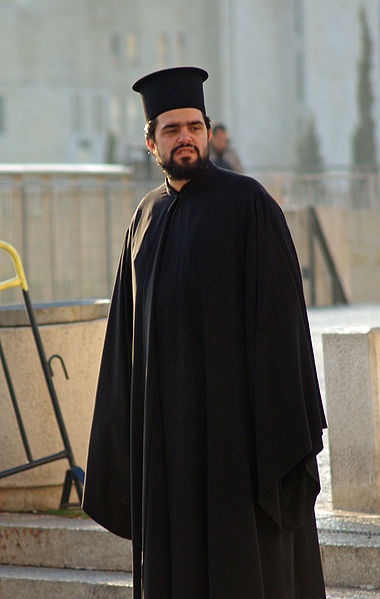Cassock
The word "cassock" probably comes from the Middle French casaque (cloak). In older days, it was known in Latin as vestis talaris.
Although the cassock was formerly the universal everyday clothing of the clergy, many, particularly in the west, have abandoned it in favor of a clerical suit of more modern design. In current usage, wearing the cassock may be a mark of a traditional cleric, though in the Orthodox Church, even those who generally do not wear cassocks continue to wear them during the services.
Contents
Eastern practice
In Byzantine and Slavic practice there are two types of cassock: the inner cassock and the outer cassock or rason. Monastics always wear black cassocks. There is no rule about coloration for non-monastic clergy, but black is the most common. Blue or grey are also seen frequently, while white is sometimes worn for Pascha.
- The inner cassock (more often simply cassock) is an ankle-length garment worn by all major and minor clergy, monastics, and often by male seminarians. The Russian version, called a podryasnik or podrjaznik (Russian: подрясник), is double-breasted, closely fitted through the torso and flaring out to the skirt, and with a high collar buttoned off-center.[1] The Greek version, called an anteri (αντερί) or zostiko (ζωστικό), is somewhat fuller, gathered at the waist with a cord, and with a high collar buttoned in the front.[2] The inner cassock is usually worn by all clergy under their liturgical vestments.
- The outer cassock also called a ryasa or riassa (Russian: ряса), or exorason (Greek: εξώρασον or simply ράσον) is a voluminous garment worn over the inner cassock by bishops, priests, deacons, and monastics as their regular outer wear.[3] It is not worn by seminarians, readers or subdeacons in the Russian tradition. In the Greek tradition, however, chanters may wear it in church, usually with no inner cassock beneath but directly over secular clothing. The outer cassock should be worn by a priest celebrating a service such as Vespers where the rubrics call for him to be less than fully vested, but it is not worn by any clergy beneath the sticharion. It may be worn with the bottoms of the sleeves turned back, which are sometimes faced in a contrasting color. The Greek version tends to be somewhat lighter weight and more fully cut than the Russian. It is originally a monastic garment.
- A cassock vest is sometimes worn over the inner cassock in cooler weather. This is a closely fitted collarless vest with patch pockets, usually falling slightly below the waist.[4]
- A cassock coat may be worn on very cold days, with the same cut as the outer cassock but slightly larger and of heavier material. It may or may not have a fur-lined collar. [5] The coat is worn over the outer cassock, although many clerics may wear it in lieu of a coat on colder days.
The cassock "symbolizes the death of a clergyman to this world, and his burial and subsequent dedication to God and his heavenly kingdom."[6]
Western practice
There are two main kinds of cassocks in Western practice; the single breasted and the double breasted cassock.
Single breasted cassock
The single breasted cassock or soutane is a cassock with buttons down the front. This type of cassock is worn by Roman Catholic priests, and comes in a number of styles or cuts, though no particular symbolism attaches to these. A Roman cassock often has a series of buttons down the front – sometimes thirty-three (symbolic of the years of the life of Jesus). A French cassock also has buttons sewn to the sleeves after the manner of a suit, and a slightly broader skirt. An Ambrosian cassock has a series of only five buttons under the neck, with a sash on the waist.
A band cincture or sash, known also as a fascia, may be worn with the cassock. The two ends that hang down by the side have silk fringes.
Double breasted cassock
The double breasted cassock or Sarum cassock fastens at the shoulders on the opposing side of the breast and at the waist with one concealed button. This type of cassock is also worn by Anglican priests.
Source
References
- ↑ Example of a Russian cassock
- ↑ Example of a Greek cassock
- ↑ Example of an outer cassock
- ↑ Example of a cassock vest
- ↑ Example of a cassock coat
- ↑ "Cassock" in A Dictionary of Orthodox Terminology
